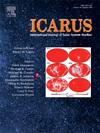Putative biosignatures in hydrovolcanic tuffs from a Mars-relevant environment: Western Snake River Plain volcanic field, Idaho
IF 2.5
2区 物理与天体物理
Q2 ASTRONOMY & ASTROPHYSICS
引用次数: 0
Abstract
Hydrovolcanic tuffs formed through magma-water interactions in lacustrine or littoral environments have been found to contain micro-textural elements, including microtubules and granular textures, within glass fragments. The morphological and associated geochemical characteristics of these micro-textures show evidence that they are formed by microbially-mediated dissolution of basaltic glass in an aqueous setting, establishing them as likely biosignatures. Further, the terrestrial setting of these samples and their basaltic composition is analogous to environmental conditions expected to have existed throughout the history of Mars.
We present the first report of putative biogenic alteration textures in basaltic glass from the Pliocene-Pleistocene hydrovolcanoes of the Western Snake River Plain volcanic field, Idaho, USA. Samples collected from tuff cones, tuff rings, and maars which erupted into paleo-Lake Idaho contain microtubules and granular alteration comparable in morphology (diameter, length, curvature, internal contents, branching) and size distribution to those recorded in other terrestrial hydrovolcanic fields. Petrographic relationships between fresh glass containing microtubules, glass that has been fully altered to palagonite, and mineral-filled vesicles and fractures indicate that tubules formed under low-temperature aqueous alteration conditions during the palagonitization process and ongoing alteration mineral precipitation. Alteration minerals including calcite and zeolites show that these fluids likely did not exceed 80 °C in temperature. Major element mapping of vitric clasts in hydrovolcanic tuff revealed most elements are depleted or neutral within microtubule interiors relative to the surrounding glass, although iron and titanium were notably enriched in many tubules. We found little distinction in major element composition between microtexture-bearing and non-microtexture-bearing glasses, with the exception of some microtexture-bearing samples being depleted in Na2O compared to the non-microtexture-bearing glass. Western Snake River Plain is relevant to Mars in terms of geochemical, mineralogical, and environmental context; and this setting is capable of preserving putative biosignatures. This work has implications for furthering our understanding of how these microtextures are formed and preserved, and for potential astrobiological investigation of Mars.
来自火星相关环境的水火山凝灰岩的假定生物特征:爱达荷州西蛇河平原火山场
在湖泊或沿海环境中,通过岩浆-水相互作用形成的水火山凝灰岩被发现在玻璃碎片中含有微结构元素,包括微管和颗粒结构。这些微观结构的形态和相关的地球化学特征表明,它们是由微生物介导的玄武岩玻璃在水环境中溶解形成的,这表明它们可能是生物特征。此外,这些样品的陆地环境及其玄武岩成分与整个火星历史中存在的环境条件类似。本文首次报道了美国爱达荷州西蛇河平原火山场上新世-更新世水火山中玄武岩玻璃的生物蚀变结构。从喷发到古爱达荷湖的凝灰岩锥、凝灰岩环和泥岩中采集的样品中含有微管和颗粒蚀变,其形态(直径、长度、曲率、内部含量、分支)和大小分布与其他陆相水火山场中记录的微管和颗粒蚀变相似。含微管的新鲜玻璃、完全蚀变为古拉贡石的玻璃、充满矿物的囊泡和裂缝之间的岩石学关系表明,微管是在古拉贡化过程和持续蚀变矿物沉淀过程中低温水蚀条件下形成的。方解石和沸石等蚀变矿物表明,这些流体的温度可能不超过80℃。水火山凝灰岩玻璃碎屑的主要元素映射显示,相对于周围的玻璃,微管内部的大多数元素是贫的或中性的,尽管铁和钛在许多微管中明显富集。除了一些含有微织构的样品在Na2O中被耗尽外,我们发现含有微织构的和不含微织构的玻璃在主要元素组成上几乎没有区别。西蛇河平原在地球化学、矿物学和环境背景方面与火星相关;这种环境能够保存假定的生物特征。这项工作对我们进一步了解这些微结构是如何形成和保存的,以及对火星的潜在天体生物学研究有重要意义。
本文章由计算机程序翻译,如有差异,请以英文原文为准。
求助全文
约1分钟内获得全文
求助全文
来源期刊

Icarus
地学天文-天文与天体物理
CiteScore
6.30
自引率
18.80%
发文量
356
审稿时长
2-4 weeks
期刊介绍:
Icarus is devoted to the publication of original contributions in the field of Solar System studies. Manuscripts reporting the results of new research - observational, experimental, or theoretical - concerning the astronomy, geology, meteorology, physics, chemistry, biology, and other scientific aspects of our Solar System or extrasolar systems are welcome. The journal generally does not publish papers devoted exclusively to the Sun, the Earth, celestial mechanics, meteoritics, or astrophysics. Icarus does not publish papers that provide "improved" versions of Bode''s law, or other numerical relations, without a sound physical basis. Icarus does not publish meeting announcements or general notices. Reviews, historical papers, and manuscripts describing spacecraft instrumentation may be considered, but only with prior approval of the editor. An entire issue of the journal is occasionally devoted to a single subject, usually arising from a conference on the same topic. The language of publication is English. American or British usage is accepted, but not a mixture of these.
 求助内容:
求助内容: 应助结果提醒方式:
应助结果提醒方式:


